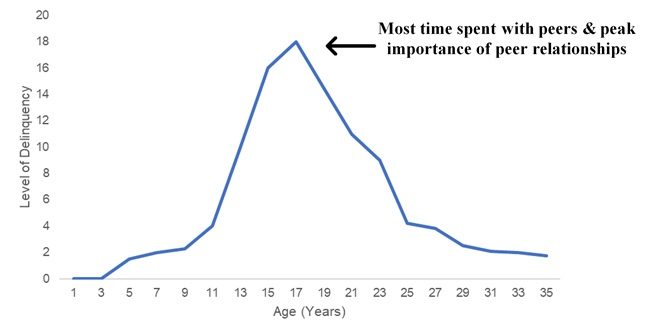9. Learning Theories
9.5 Research in Learning Theories
Dr. Zachary Rowan and Michaela McGuire, M.A.
Deviant sources of influence have been demonstrated to be one of the most robust predictors of crime. Research indicates that deviant association with friends (e.g., Fergusson et al., 2007; Haynie, 2002), best friends (e.g., Rees & Pogarsky, 2011), siblings (e.g., Hashimi et al., 2021; Rowan, 2016), co-workers (e.g., Piquero et al., 2005), gang members (e.g., Kissner & Pyrooz, 2009), romantic partners (e.g., Capaldi et al., 2008; Haynie et al., 2005), indirect ties (e.g., Payne & Cornwell, 2007), and university roommates (e.g., Duncan et al., 2005) can explain why individuals participate in criminal behaviour.
A meta-analysis, which synthesises all available research on a particular topic and provides an overall estimate of the empirical relationship, conducted by Pratt et al. (2010) indicated that the impact of deviant associations was moderately strong and equally as important as key factors identified by other criminological theories (i.e., self-control). Importantly, Pratt et al. (2010) examined the effects of each of the components of SLT separately and found that differential reinforcements (i.e., the main addition to the revised theory) had the overall weakest effects in explaining crime. While this does not negate the role that reinforcements play, it does suggest that Sutherland’s (1947) concept of differential associations remains a significant factor in learning frameworks of crime.
Although most research testing SLT or differential association theory focuses on examining the relationship between deviant peers and crime, other research has demonstrated the role that peers play in explaining other important relationships in criminology. As stated, Sutherland (1947) argued that a strong theory should be able to explain key correlates of crime, such as age or gender. The research reviewed below provides some evidence to support the capacity of peers and learning mechanisms to help us understand these features of crime.
Age & Peers
Perhaps, the closest thing to a “fact” that exists in criminology is the relationship between age and crime, also known as the age-crime curve (e.g., Piquero et al., 2003). It has been established across a variety of contexts that criminal behaviour rapidly increases in adolescence until the late teenage years and quickly declines thereafter. Warr (1993) evaluated the extent to which peers could help explain this relationship. Warr (1993) noted that interactions with delinquent peers, time spent with peers, and the importance individuals assign to spending time with peers similarly mapped onto the age-crime curve. As youth enter their teenage years, they are more likely to have delinquent friends, spend time with them, and believe it is important to do so. Figure 3 demonstrates the typical relationship between age and crime and highlights when individuals spend the most time with peers in social settings and place importance on choosing to spend their time in this way (Warr, 1993). In many ways, learning theories are specifically oriented towards explaining the crime phenomenon during adolescence and young adulthood (e.g., Ragan, 2020).

Gender & Peers
It is generally well established that males to commit the majority of crime (e.g., Mahony et al., 2018). Scholars have considered the role that peers and the learning mechanisms described by SLT play in differentiating the rates of crime by males and females. Research has suggested that males are exposed to deviant peers more than females (e.g., Mears et al., 1998; Smith & Paternoster, 1987) and differentially experience the impact of deviant peers. Females tend to have socialisation experiences that encourage morals that are not favourable to risk and therefore not supportive of crime (Hagan et al., 1990; Hagan et al., 1987) and females tend to be more closely supervised by their parents (LaGrange & Silverman, 1999, as cited in Koon-Magnin et al., 2016), both of which limit the impact that being exposed to deviant peers has on whether they engage in crime. Thus, males are not only more likely to be exposed to definitions favourable to crime, but relative to females, males are simply more susceptible to that exposure because of gender differences in socialization (Hagan et al., 1990; Hagan et al., 1987). Learning mechanisms can also go beyond explaining crime from a purely biological perspective, as research indicates that norms oriented around masculinity (e.g., controlling emotions, the drive to win, appearing heterosexual) are reinforced by peers and explain why males who disproportionately express such norms engage in crime (e.g., Iwamoto & Smiler, 2013).
Turning Points & Peers
Considering the previously mentioned relationship between age and crime, we also know that there are factors that help change the trajectory of offending in early adulthood. Figure 4 illustrates the same age-crime relationship and highlights that when individuals enter adulthood, they find jobs, get married, and possibly serve in the military. Life course theorists have described these as “turning points” and have demonstrated that when individuals experience these turning points, they are more likely to desist from crime (e.g., Laub & Sampson, 1993). Warr (1998) discovered that married individuals report spending less time with friends and therefore reduce their number of delinquent associations. Wright and Cullen (2004) examined the role of employment in reducing crime and found that while having a job did reduce offending by increasing one’s commitment and involvement with prosocial institutions, this reduction in offending was also explained by the fact that coworkers in those jobs disapproved of crime. Thus, peers in the workplace and the definitions they expose individuals to also play an important role in changing behaviour. These findings suggest that the impact of these turning points is due to more than just changes in attachment to sources of informal social control (e.g., partner, job), but additionally the social contacts that also change as a result of these shifts in adult responsibilities.


